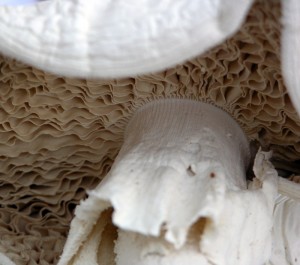A Foray For Fungi—and For Citizen Scientists
Posted in Travelogue on January 15, 2014 by Shannon Asencio
Shannon Asencio, who works at The New York Botanical Garden’s William and Lynda Steere Herbarium, is the Project Coordinator for the Macrofungi Collection Consortium. This Garden-led project, involving institutions across the country, will result in a publicly accessible database and digitized images of several hundred thousand specimens of mushrooms and related fungi.

A couple of months ago, I attended the 2013 “foray” of the North American Mycological Association (NAMA), held at Shepherd of the Ozarks in northern Arkansas. I was there not only to participate in the search for mushrooms—mycology is the study of mushrooms and other fungi—but also to deliver a presentation on The New York Botanical Garden’s exciting new crowdsourcing initiative.
These annual forays are a way to record the mycological species that occur throughout North America. The collection data, photographs, and dried specimens are housed at the herbarium of the Field Museum of Natural History in Chicago. These specimen records provide data about the distribution of macrofungi—mushrooms and other large fungi species—in North America and serve as a resource for additional studies, such as DNA research.
A group of fungi foragers was the perfect audience for my talk about The New York Botanical Garden’s crowdsourcing project. We’ve launched a new website that enlists citizen scientists to help digitize the world’s mycological collections, one record at a time! We’re working in partnership with Notes from Nature, a citizen-science transcription project that involves scientific collections from more than 200 institutions.
In our case, the labels of macrofungi specimens are filled with meticulously recorded information that has to be transcribed by people, not computers. Contributing to the larger scientific goal of understanding what macrofungi species we have out there, and where and when they were collected, is a great way to help conserve these wonderful marvels of nature. You can lend a hand by getting started today at Notes from Nature, and we’ll describe the macrofungi project in more detail in a future post.


I am on the program committee of COMA, Ct.-Westchester Mycological Association. Would you be interested in giving our club your program about the macro fungi project? Please email me at the above address. I would appreciate a reply asap as we are right not in the process of firming up our speakers for the year.
Thanks. Rena